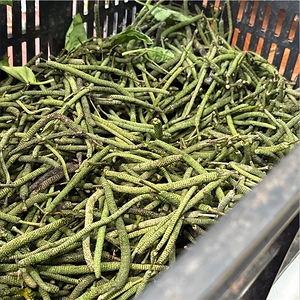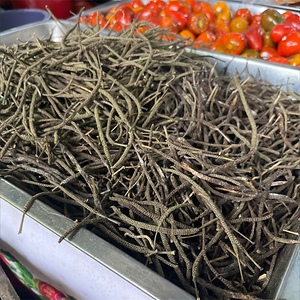


Pipilongo
Estimated Inventory, lb : 0
Description/Taste
Pipilongo is comprised of slender pods, averaging 6 to 10 centimeters in length, and has a straight, cylindrical shape with rounded, curved ends. The pods grow upright along branches and showcase a narrow and elongated nature made up of many tiny seeds. The pod's surface is textured, wrinkled, and bumpy and exhibits variegated green, yellow, and dark brown hues. Underneath the skin, there is a very thin layer of green flesh and light brown, crunchy seeds. Pipilongo pods are customarily sun-dried and are used whole or ground into a spice in culinary dishes. The pods add a clean, zesty, musky, and peppery flavoring with woody, vegetal, and soft menthol-like nuances.
Seasons/Availability
Pipilongo is available year-round.
Current Facts
Pipilongo, botanically classified as Piper tuberculatum, is a rare species belonging to the Piperaceae family. The pods grow upright on small trees reaching 6 to 7 meters in height and are a robust species utilized as a flavoring in raw and cooked preparations. Historically, Pipilongo grows wild throughout the Americas, but the unusual pods are primarily used as a black pepper substitute in regions of western Colombia, especially among Afro-descendant communities. Pipilongo is a more affordable alternative to black pepper, and the dried pod's flavor is complex, combining pungent notes with a lingering menthol-like aftertaste. Growers favor the species for their fast-growing nature, multiple crops per year, and tolerance to a wide range of environmental changes. In the modern day, Pipilongo is still hand-harvested in Colombia on a small scale as a culinary ingredient, but its existence has decreased due to the introduction of other spice blends. The pods are also an important ingredient in homeopathic remedies and natural medicines.
Nutritional Value
Pipilongo has not been extensively studied for its nutritional properties. The pods are a source of antioxidants to protect the cells against the damage caused by oxidative stress and free radicals, and piperine acts as an anti-inflammatory within the body. In natural medicines, Pipilongo is used in teas and infusions to act as a decongestant or remedy to soothe cold symptoms. Beverages infused with the pods can also be mixed with honey, sugar, or brown sugar to help coat the throat and provide decongestant properties. The leaves of the species are used in topical treatments to heal snake bites.
Applications
Pipilongo has a peppery, vegetal, and woody flavor suited for raw and cooked preparations. The pods can be used fresh or dried and are popularly added whole to sancocho, a traditional stew-like soup made with meats, starches, and vegetables. Pipilongo is used as a natural seasoning and has a flavor similar to the zinginess of black pepper. The pods can be crushed and sprinkled over dishes just before serving and complement savory soups, stews, rice dishes, or cooked vegetable recipes. The pods can also be used in salads and slaws, or dry rubbed onto meats for enhanced flavoring. In the department of Chocó, a liquor is made from Pipilongo. The ground pods are also folded into arepas or empanadas. Pipilongo pairs well with meats such as beef, poultry, and pork, corn, potatoes, rice, citrus juice, coconut milk, and cilantro. Whole Pipilongo peppers should be used immediately for the best quality and flavor or dried in the sun and stored in a sealed container for extended use.
Ethnic/Cultural Info
Pipilongo is a staple home garden plant in the village of Robles in the Valle del Cauca in western Colombia. Robles is one of the few places worldwide that cultivates Pipilongo and reveres the pods for their complex flavor qualities. Almost every home garden features a Pipilongo tree, and the pods are used as a culinary alternative to pepper and other spices. Some Pipilongo trees are also planted throughout the village and harvested for retail in fresh local markets, and there are wild trees left intact to provide food for native wildlife, including bats, birds, and insects. In Robles, Pipilongo is famously incorporated into a sauce in a recipe known as Chucha, and the recipe is recorded in the book titled Fogón Vallecaucano: Cocinas del Valle, Mar, y Montana.
Geography/History
Pipilongo is a species growing wild in the Americas and is found in regions extending from Mexico to Brazil, with concentrated populations in Colombia. The fast-growing plants thrive in forests, pastures, flood-prone zones, and along hillsides, typically between 1,000 to 1,200 meters in elevation. Pipilongo belongs to the same genus and botanical family as the long pepper, Piper longum, and several legends point to how Pipilongo may have been a descendant of ancient plants from Asia. One legend hypothesizes that a type of long pepper plant was at one time carried on galleon ships journeying between Asia and Colombia and was planted in coastal bogs. Over time, the plants were utilized among the Afro-descendant peoples within Colombia and were carried to other regions for expanded use and low-level cultivation. Throughout years of naturalization, the plants evolved into the species known as Pipilongo. Today Pipilongo is a rare species primarily found in fresh markets of Colombia in the Valle del Cauca and the towns of Quinamayó, Robles, Suárez, Potrerito, and Timba. It can also be found throughout other regions of Central and South America.









